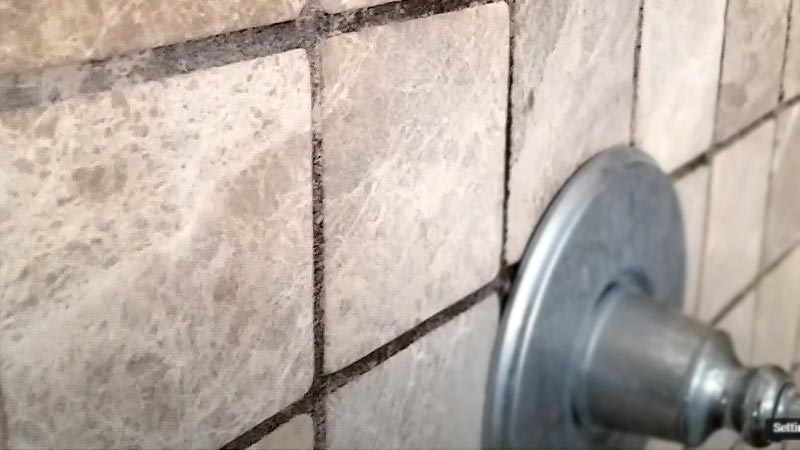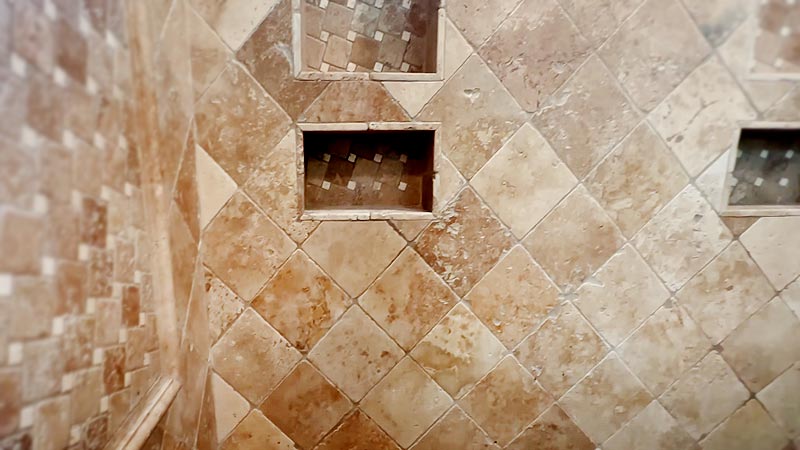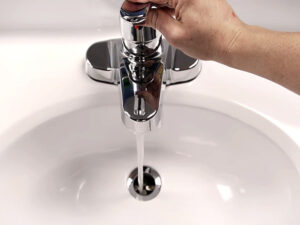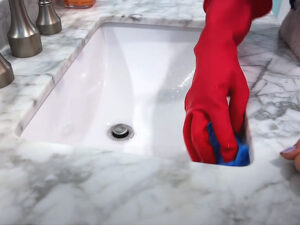With its classic and refined look, marble is a widely used material for shower surfaces. But additional attention is needed to keep your travertine shower clean and in good condition. This blog post will go over the necessary procedures for keeping your travertine shower clean and in good condition so that it always looks lovely and feels welcoming.
Cleaning other surfaces is not the same as cleaning travertine in a shower. Because it’s a natural stone, some cleaning agents and techniques may cause irritation. This guide is meant to make things easier and provide everyone with clear, concise instructions.
We will go over the basics, including stain removal and weekly cleaning procedures. We will also talk about how important it is to seal your travertine. With the aid of this advice, you can get a clean and well-preserved travertine shower, regardless of whether you’re new to the material or want to update your cleaning routine.
Why is Travertine used in Showers and what does it mean?
One type of natural stone is travertine. Its robust design and attractive appearance make it a popular choice for showers. People use it to create elegant and durable showers.
Earth is the source of travertine. It is composed of a long-lasting mixture of water and minerals. Because of this, the stone is sturdy and firm. It has a smooth, pleasant-to-touch surface once it has been cut and polished.

Because travertine appears so elegant, people want to use it in their showers. Its hue is distinct and cozy. It may have a mixture of reddish, beige, tan, or creamy white tones. The shower appears cozy and welcoming thanks to these color schemes.
Travertine is powerful as well. Water and general wear and tear are not going to break it. Water sprays all over the place when you’re in the shower. Water does not readily corrode travertine. It’s safe for shower floors because it’s also not particularly slippery.
Not only is travertine utilized for shower walls and floors, but it’s also used for worktops and sinks. It is beneficial for those who like to give their bathrooms a natural, earthy aesthetic. It’s similar to adding a little bit of outside space within your house.
However, there are a few crucial details about travertine. It must be appropriately cared for. It has to be cleaned using mild solutions, not strong ones. To keep it free from dirt and stains, you should seal it as well. It will last a long time and maintain the attractive appearance of your shower if you take care of it.
To put it simply, travertine is a stunning and robust natural stone. Due to its excellent water-handling capabilities and attractive appearance, many choose to use it in their showers. It will make your shower a comfortable and fashionable space as long as you remember to take care of it.
How to Clean Travertine in Shower: A Step-by-Step Guide
Because travertine is a natural stone that might be sensitive to some cleaning agents, washing it in a shower calls for caution and attention. This is a detailed tutorial on how to clean travertine in a shower:

Supplies You’ll Need
Use a mild, pH-neutral stone cleaning or travertine cleaner that has been particularly designed.
- Mild pH-neutral stone cleaner or a specially formulated travertine cleaner
- Warm water
- Soft, lint-free cloths or a sponge
- A squeegee
- Baking soda (optional)
- Grout brush (optional)
- Sealer (optional)
Step 1: Eliminate any Surface Debris
Getting rid of any loose dirt, soap scum, or other debris that may be on the travertine should be your first step. This may be accomplished by gently wiping it away with a dry cloth or sponge. It will be easy to proceed after this.
Step2: Get a Cleaning Solution Ready
You need a cleaning solution in order to clean the travertine. The stone shouldn’t be harmed by this moderate solution. Either manufacture your own or get a specialized cleaner designed for travertine.
Make your own by combining a little amount of warm water with a mild stone cleanser. To obtain the proper combination, make sure you adhere to the directions on the cleaner’s packaging.
Step 3: Use the Cleansing Agent
It’s time to utilize the homemade or purchased cleaning solution. For this, you will need a sponge or a soft cloth. To begin, submerge the sponge or cloth in the cleaning solution. Next, lightly press it to remove any remaining water.
Too much moisture on the sponge or towel might harm the stone, so avoid that. Next, use a towel or sponge to gently clean the travertine. It is crucial to avoid using anything abrasive or hard as this might damage the stone.
Step 4: Grout Cleaning (If Necessary)
You might need to clean the grout-filled lines in your shower. Over time, these lines may get discolored and soiled. You can use a specific brush designed for this purpose to clean the grout. Don’t worry if you don’t have a grout brush. Baking soda and water can be used to create a basic cleaning paste.
- Take a handful of baking soda, a white powder that you might already have in your kitchen.
- To make a thick paste, mix it with water. It’s similar to making dough by combining flour and water.
- When the paste is complete, use a cloth or brush to gently scrape it into the grout lines.
This aids in removing any discoloration or stains. Make sure to give the grout lines a good rinse after cleaning them. Rinsing removes the cleaning paste and any dirt that the grout may have taken up, much like giving it a nice shower.
Step 5: Give it a Good Rinse
It’s crucial to give everything a good rinse after cleaning the grout or the remainder of your shower. This entails washing away any remaining cleaning solution with warm, clean water. Rinsing is like taking a good, long bath in your cleaned shower. It guarantees that no dirt or chemicals are left behind.
Step 6: Surface Drying
The travertine surface has to be dried in order to complete the cleaning procedure. It’s similar to using a towel to pat yourself dry after having a shower. It’s crucial since it lessens the likelihood of water stains and streaks. This may be accomplished by using a gentle cloth that doesn’t gather lint.
Like a towel that leaves no fuzz behind, a lint-free fabric does not leave any. An alternative is to use a squeegee, which is a specialized instrument. Similar to a rubber blade, a squeegee aids in the removal of water. You can maintain the surface’s appearance and stop any marks from appearing by drying it.
Step 7: Sealing Is An Option.
You may want to consider using a sealer if you have never sealed your travertine shower or if it has been a while since the previous sealing. A sealer is similar to an outer layer of defense for the travertine in your shower. It is designed only for natural stone, such as travertine.
Although sealing is not required, it might be a good idea since it helps shield the stone from stains and moisture. See it as an additional layer of protection, similar to applying sunscreen on your skin before venturing outside in the sun.
Travertine will look better and last longer if it is cleaned and sealed on a regular basis. It is very important not to use rough materials or chemicals that are too strong for the stone. Pay attention to the goods you use and always do what the maker says for maintenance and care.
Are there any Other Ways to Clean?
Yes, there are other ways to clean travertine in a shower, but you should exercise caution and use techniques that are safe and gentle on the stone. You may want to think about the following substitute cleaning techniques:

1. Water and Vinegar
Travertine surfaces may be cleaned naturally with a solution made of equal parts white vinegar and water. White vinegar can aid in the breakdown of mineral deposits and soap scum due to its moderate acidity.
Use of this solution must be limited, though, since prolonged exposure to acidity may eventually tarnish the stone’s look. Make sure to completely rinse the area with clean water after using the vinegar and water mixture to get rid of any leftover residue.
This technique works well for spot cleaning and shouldn’t be applied to the stone frequently.
2. Baking Soda and Lemon Juice
Travertine may be naturally cleaned with a paste made of baking soda, a light abrasive, and lemon juice, which is renowned for its mild acidity. This combination works well for removing soap scum and stains.
This approach involves making a paste out of baking soda and lemon juice, applying it to the discolored spots, letting it set for a little while, and then gently scrubbing the travertine surface.
Finally, make sure that all traces of the paste are gone by giving the area a thorough rinsing. When used sparingly, baking soda and lemon juice are harmless and can help bring back the original brilliance of the stone.
3. Using Baking Soda and Hydrogen Peroxide
Making a cleaning mixture with baking soda and hydrogen peroxide is another all-natural option. When used as a mild cleaning solution, hydrogen peroxide works well to get rid of stains and discolorations from travertine.
Mix the two together to make a paste, apply it to the stains, allow it to set for a short while, and then give the stone’s surface a light scrape. As with the earlier techniques, make sure to completely rinse to get rid of any paste residue. In particular, this technique can be helpful for more tenacious discolorations and stains.
4. Cleaning Using Steam
High-temperature steam is used in the steam cleaning process to clean and sterilize a variety of surfaces, including travertine. Without the use of harsh chemicals, steam cleaners may successfully remove dirt, grime, and stains from stone when used properly.
It’s crucial to use a steam cleaner made especially for stone surfaces and to closely adhere to the manufacturer’s recommendations. Although steam cleaning might be more comprehensive and environmentally friendlier than other methods, it must be handled carefully to prevent surface damage to stone.
5. Commercial Stone Cleaners
Stone surfaces such as travertine require specialized cleaning agents, which are called commercial stone cleaners. These products are designed to clean surfaces effectively without causing damage to the stone. They are a dependable and practical solution for keeping your shower’s travertine intact.
Pay great attention to the manufacturer’s directions while using a commercial stone cleaner. With a lower chance of inadvertently damaging the stone, these solutions are a secure option for regular cleaning and upkeep of your travertine shower.
Although these alternate techniques for cleaning travertine can be successful, it’s crucial to use them cautiously and sparingly. To be sure a new cleaning technique doesn’t damage the stone or alter its look, always try it in a discrete area first. Furthermore, steer clear of scouring pads, strong chemicals, and abrasive materials since they might harm travertine surfaces.
How to Keep Your Travertine Shower in Good Condition
Maintaining the excellent condition of your travertine shower doesn’t have to be difficult. Here are some helpful pointers to make sure your shower stays lovely and spotless throughout time:
1. Continual Cleaning
Regular cleaning of your travertine shower is essential. By doing this, the travertine surface is kept free of mineral deposits and soap scum accumulation. Consider it as routinely decluttering your space to maintain its orderly and welcoming appearance. Cleaning your shower often will help you minimize the amount of debris and grime that builds up.
2. Don’t Use Harsh Cleaners
You need to be very careful when cleaning your travertine. Avoid using abrasive or acidic cleansers. The stone’s surface may be harmed by these strong chemicals, giving it a worn-out appearance. Alternatively, use specialized travertine cleansers or gentle pH-neutral stone cleaners. These provide a thorough but secure clean, much like mild soaps for your shower.
3. Squeegee Use
Using a squeegee is a good idea after every shower. Similar to a specialized instrument, a squeegee aids in removing extra water from the walls and floor. To keep your floors clean, imagine doing this as wiping your feet on a doormat. You may avoid mineral build-up and water stains by using a squeegee. It is a simple, quick step that may have a significant impact.
4. Deal With Stains Right Away
It’s important to take care of stains as soon as you see them since they might occur. Don’t wait until they are harder to get rid of. Consider it as quickly clearing up a spill on your kitchen counter to avoid creating a sticky mess. Stains may be removed with the same moderate cleaning techniques that were previously discussed, including a baking soda paste or a mild stone cleanser. The stains will be simpler to remove if you take action quickly.
5. Closing
Your travertine shower may benefit from a sealant. Sealing is similar to giving the surfaces of your shower an additional layer of defense. It acts as a barrier against stains and dampness. Consider it similar to putting on a raincoat when the weather is bad. The amount of use and moisture exposure determine how frequently you should reseal your travertine. Generally, it’s a good idea to do this every 1-2 years or as needed.
To sum up, taking care of your travertine shower requires routine cleaning, staying away from harsh chemicals, squeezing out water spots, removing stains as soon as possible, and thinking about applying a sealer.
You may have a gorgeous, long-lasting shower that remains spotless and welcoming for many years to come by following these instructions and properly caring after your travertine.
These little habits may have a major impact on maintaining the finest possible appearance for your travertine shower, just like house maintenance does.
Can I use bleach to clean my travertine shower?
It is not advised to clean your travertine shower with bleach. Bleach is a powerful and abrasive chemical that can damage the stone’s inherent beauty. Over time, it can harm the surface, undermine any sealer that could be applied, and result in discoloration. This implies that using bleach may cause long-term problems for your travertine. It is preferable to use softer cleaning agents made especially for natural stone, like travertine, rather than bleach.
Travertine is better cleaned with these stone-specific or pH-neutral solutions. They are gentler and won’t damage the surface or beauty of the stone. If a softer cleaner could accomplish the same task without endangering your lovely travertine shower, it would be preferable to use bleach, which is like using a really potent cleaning.
In summary, stay away from using bleach on your travertine shower. To maintain the best-looking travertine without running the risk of damaging it, use softer, stone-friendly cleaning agents. It’s an easy technique to make sure the beauty of your shower lasts for a long time.
What should I do if my travertine shower has stains from hard water?
There are methods to assist in gently removing hard water stains from your travertine shower. Your shower may appear discolored or drab due to hard water stains, but there are a few tricks you may attempt to restore its luster.
Using a solution of white vinegar and water is a wonderful place to start. Combine both in equal amounts, much like you would juice and water in a cup. This produces a solution that may aid in removing the stains left by hard water. The mixture should be gently rubbed on the discolored regions with a soft cloth or sponge.
But always remember to be kind. Consider it analogous to hand-washing a delicate blouse. Make sure to completely rinse the shower with clean water after applying the mixture. This is similar to taking a great bath after using a shower to remove the solution and any loose particles.
Another crucial step is avoiding these stains going forward. You may use a squeegee to wipe away extra water from the walls and floor after every shower. This lessens the likelihood of mineral accumulation and water spots, which might result in these stains. It is comparable to drying a plate to avoid watermarks. Although it may require a bit more work, it keeps the appearance of your shower good.
Recall that handling stains from hard water on travertine requires caution. Because of its sensitivity, this lovely stone should not be cleaned with abrasive or strong cleansers. It might be beneficial to employ mild techniques, such as the vinegar and water combo. Additionally, to avoid doing any harm to the stone, always remember to thoroughly rinse after using any cleaning solution.
Is it possible to use scouring pads or abrasive scrubbers on travertine?
It is not advisable to use scouring pads or abrasive scrubbers on travertine. These abrasive cleaning instruments may cause scratches and other damage to the stone’s surface that is frequently difficult to fix. Compared to some other materials, natural stone like travertine is more prone to scratches and abrasions because of its fragile and porous nature.
Use soft towels, sponges, or brushes made especially for stone surfaces as delicate cleaning instruments rather than abrasive scrubbers. Travertine can be cleaned efficiently and without damaging it using this equipment. Even a soft cloth can harm the stone if it is rubbed vigorously, thus cleaning requires patience and avoidance of using undue force.
Using the proper cleaning equipment is a critical aspect of maintaining the integrity and aesthetics of your travertine shower. You can contribute to keeping your travertine attractive and free from abrasions and scratches by being gentle and using the right cleaning solutions. Recall that when it comes to stone care, prevention is usually the best course of action. You can safeguard your travertine investment by staying away from scouring pads and abrasive scrubbers.
How often should I reseal my travertine shower?
How frequently should you reseal your travertine shower, you might be wondering. The answer, however, may vary depending on how frequently you take showers and how much moisture they get. Re-sealing your travertine shower is generally a good idea, and should be done every one to two years.
Applying a few droplets of water to the travertine surface is an easy method to determine whether it’s time to reseal. You don’t need to reseal right away if the water beads up and doesn’t seep into the stone, indicating that the sealer is still effective. On the other hand, if water seeps into the stone in a matter of minutes, the sealer has worn off and a reseal is necessary to keep your travertine protected.
Resealing the travertine helps prevent moisture and stains from seeping in by forming a protective layer on the surface. It is comparable to donning a raincoat while it is pouring outdoors. The travertine may be more susceptible to stains and damage in the absence of this barrier. Thus, to maintain the finest possible appearance for your travertine shower, you may monitor the results of the water test to determine when to reseal.
Keep in mind that you don’t need to reseal every week or month. It’s more of an occasional chore, and how often you do it will depend on the particulars of your shower. You can always get expert counsel for the greatest advice on the demands of your travertine shower if you’re unsure of the timing. You may prolong the beauty and protection of your shower by resealing it when necessary.
Is it possible to clean my travertine shower using dish soap?
It is not a good idea to clean your travertine shower using dish soap. Dish soap works well for cleaning dishes, but it isn’t the best option for travertine. This is the reason why:
One kind of natural stone that is porous and susceptible to certain chemicals is called travertine. Even mild dish soap can leave a film on the top of the travertine. Over time, this residue may cause the stone’s inherent sheen to fade and its appearance to become less desirable. Additionally, it may leave a film behind that may eventually collect debris and make cleaning your travertine shower more difficult.
It is preferable to use pH-neutral stone cleaners or specifically designed travertine cleansers to preserve the finest possible appearance for your travertine shower. These cleaning solutions are made to efficiently clean stone without harming it or leaving residue behind.
Can I use a pressure washer to clean my travertine shower walls and floor?
It is not advisable to use a power washer to clean the walls and floor of your travertine shower. Strong appliances like pressure washers may shoot water at high pressure, which might be too strong for travertine surfaces. The powerful water jet may cause etching, pitting, or even loosening of the grout on the stone’s surface. Imagine attempting to clean a priceless work of art with a fire hose—it’s simply too strong and can cause more damage than good.
Since the natural stone travertine is frequently exposed to water, soap, and shampoo in showers, it can be quite sensitive to pressure. Using softer cleaning techniques is both safer and more appropriate than using a power washer. Using soft towels, sponges, or stone-specific brushes, together with pH-neutral or stone-specific cleansers, you may efficiently clean your travertine shower. These techniques prolong the life and aesthetic appeal of your shower.
There are more options to think about, such as utilizing professional stone cleaners or natural DIY remedies like baking soda and water, if your travertine shower needs deeper cleaning or has stubborn stains. These can clean well without running the risk of causing harm like a power washer does. To get rid of any cleaning solution residue, it’s also critical to use the right cleaning methods and to rinse well.
Keep in mind that the best method to preserve the beauty of your travertine shower and prevent any unintended damage is to clean it gently and cautiously. Although using a pressure washer can seem like a quick fix, doing so may require expensive repairs or replacements in the future.
Final Words
With any luck, this tutorial has made cleaning your travertine shower a simpler and less daunting chore. You can maintain the finest possible appearance for years to come for your travertine shower by using the advice and techniques provided in this piece. Keep in mind that maintaining the natural beauty of travertine requires frequent cleaning, delicate care, and appropriate upkeep. The techniques covered in this article offer workable remedies for both common soap scum and difficult stains. A spotless travertine shower may be kept as an opulent and welcoming feature of your house with a little time and work.







